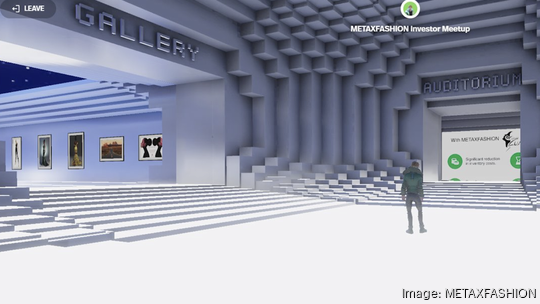
A Valley-based company is developing what it describes as the first non-fungible token (NFT) ecosystem for fashion brands and designers.
Metaxfashion, founded by entrepreneur Brendan Gage and manufacturing expert Hermann Plank in 2022, is a decentralized blockchain application that provides fashion brands and designers with training and tools to grow in the digital world.
The company's fashion ecosystem, when launched, will allow designers to create digital twins of physical garments, authenticate items via NFT smart contracts stored on the blockchain and host virtual reality runway shows in the metaverse.
“To make an NFT system, you need to digitize your products. My two passions are product development as a plastics engineer and I love fashion," said Plank, who has served on the Phoenix Fashion Week advisory board. "I saw a trend in the last couple of years where fashion became digitized. Some people moved away from 2D patterns and hand-drawn sketches to drafting a dress or T-shirt using computer-aided software. Those 3D files are prerequisites to creating an NFT. I saw an opportunity to combine that with blockchain technology."
Plank is also creating the platform to boost sustainability in the fashion world while reducing time-to-market for designers.
Last year, the Algorand Foundation awarded Metaxfashion a $150,000 grant to develop its NFT fashion ecosystem on the Algorand blockchain. In addition, the company hired Arizona State University’s Blockchain Research Lab to create the back-end of the fashion ecosystem.
“We were looking around the country and found a really good team right in our backyard in Arizona," Plank said of ASU's Blockchain Research Lab.
The Algorand blockchain, designed by MIT professor Silvio Micali, is a carbon-neutral platform that achieves speed, security and decentralization at the same time, according to the platform's website.
Shift to a digital world
NFTs can be used to protect intellectual property, verify authenticity of a garment, finance new collections, and sell designs directly to fashion houses at a fraction of the cost of other platforms, Plank said.
"Designers can mint an NFT of a T-shirt, dress or pair of pants by uploading special design files and a tech pack through our system and when they sell the NFT to a big retailer, they would sell the whole design," Plank said. "This retailer could take the files, have it sent to their manufacturer in Los Angeles, China or Europe and have it manufactured from the digital files attached to the NFT.”
NFTs can cost between $50 to $150 to mint on Ethereum’s blockchain, while it costs around 2 cents to mint NFTs on Algorand's blockchain at the current rate, he added.
Fashion brands could also create limited edition NFTs of clothing items that are connected to special perks, such as a sale on an upcoming product launch or preview of a future collection. Designers would decide whether the NFT would be a photo of the garment or include the physical item as well.
Metaxfashion is onboarding designers to teach them how to use the fashion ecosystem with plans for a rollout in the summer. The company has already garnered interest from designers and is slated to be a keynote speaker at Michigan Fashion Week later in the year, Plank said.

Metaxfashion's ecosystem brings potential for designers to create pop-up stores, fashion shows and lookbooks, Plank said.
The company created a 3D dress on a rotating avatar for House of Zuri, a Tucson-based fashion agency after it provided a garment sketch and pictures of the fabric, zippers and buttons.
Metaxfashion is working on a prototype for FashionChain, which will provide designers and suppliers the ability to view real-time data for their carbon emissions. That platform is slated to launch in spring 2024, Plank said.
The company has been in discussions with venture capital firms, but has not yet inked any funding deals. Currently, Metaxfashion is focused on informing the fashion industry about its platform.
“We are the first to offer this type of technology, but we also take into account that 99% of people don’t know what the blockchain is and that includes fashion designers,” Plank said. “So we are starting now with awareness and education.
“The key is to really bring back the basics and explain step-by-step how can a designer can start sketching a t-shirt on the computer, get a digital design and get it to the market without cutting one piece of clothing,” Plank added.
Wave of the future
Arizona Fashion Source, a Tempe-based multiline apparel manufacturer, is looking forward to Metaxfashion's ecosystem launch, said founder Sherri Barry.
“We have hundreds of designers and really feel that digital gives them a more creative onramp to display their products,” Barry said. “If Hermann has this platform for designers with an easy cost of entry point and they can also create NFTs for a very low cost, it allows all of the smaller emerging designers a chance to experiment in this new frontier.”
Arizona Fashion Source, along with FABRIC Incubator, provides emerging designers with resources including fashion education, design, product development and pre-production services.
With the changing landscape of how people buy and sell clothes, there’s a need for a process to make a digital twin of physical garments, Barry said.
A digital twin of a garment refers to its real-time physical counterpart and follows the process in which its created. For example, a digital twin of a garment can contain information about the designer, fabrics used to create it, measurements and whether it’s part of a limited-edition collection, among other things.
“We are leaning into the fact that fashion now has two avenues: there’s a digital product and a physical product,” Barry said. “We believe most product design and development is created digitally.”
Big fashion brands are entering the metaverse, including Ralph Lauren, which launched a digital collection on Roblox in 2021, Barry added.
“This really is the wave of the future,” Barry said. “I know that a lot of people have digital wallets, but the speed is picking up and everything to do with (augmented reality) and (artificial intelligence) will accelerate it.”











